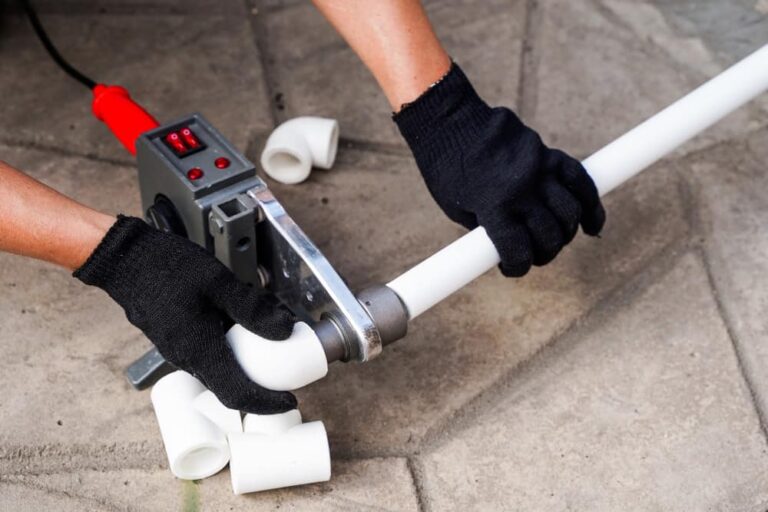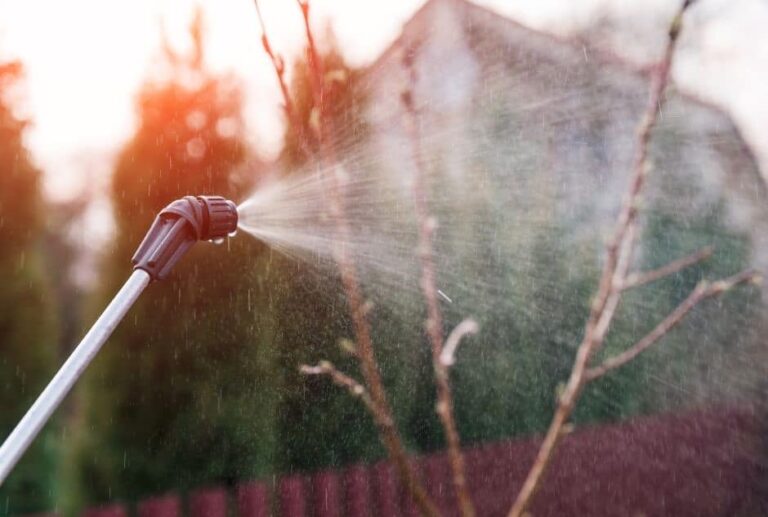How to Repair PVC Pipe in Tight Spaces: The Step-by-Step Guide
Unless you’re a plumber, there will probably come a time when you need to repair PVC pipe in a tight space. The good news is that repairing PVC pipe is more manageable than replacing it. With the proper tools and techniques, even those with little plumbing experience can fix small sections of PVC pipe.
When repairing PVC pipes, your primary concern should be preventing water from getting into unwanted places again. To do this, you must ensure there are no weak spots in the pipe where leaks could start again. Then, you just need to repair the break as best as possible and test until it does not leak anymore. Read everything you need about How to Repair PVC Pipe in Tight Spaces.

What to do if your PVC pipe is cracked
If your PVC line is cracked, it’s important to take action immediately. A cracked pipe can allow water to seep into unwanted places, leading to extensive damage over time. Plus, a leaking pipe can be a safety hazard.
Most leaks are small and can be fixed relatively quickly. But, some are more serious and could result in significant damage if left untreated. Failing to act quickly can lead to problems like flooding or mold growth.
There are a few things you can do
- Turn off the main water valve (if applicable) and drain the system of any standing water (e.g., bathtub, sink).
- Until the problem is fixed, turn off the main water supply.
- Use a clean cloth to dry the area around the leak. A leak in a pipe behind a wall, ceiling, or floor must be repaired as soon as possible to prevent further damage.
Tips for preventing future cracks in your PVC pipes
You should take certain precautions to avoid PVC pipe cracks in the future.
- Always make sure that the pipes are properly supported. This will help prevent them from sagging over time, which can stress the pipes and cause them to crack.
- Avoid using too much force when installing or removing fittings. The pipes could crack as a result of this.
- Use the correct pipe size for your pipes. Using a fitting that is too small can overstress the pipes and cause them to break.
- Clean your pipes regularly to remove any dust or grime causing the cracks.
- Make sure you replace any cracked pipes as soon as possible.
- Keep an eye on any areas around the house that could be causing damage to your pipes and fix them as soon as possible.
These simple steps ensure that your PVC pipes are protected and stay in good working order for many years.
How to Repair PVC Pipe in Tight Spaces: Different Techniques
When dealing with a cracked PVC pipe, it’s important to know how to fix it properly. Cracks in PVC pipes can lead to water damage and other problems, so it’s best to repair them as soon as possible. Here are some strategies for repairing PVC pipe in tight spaces:
1. Replacing the Pipe
The Step-by-Step Guide
- Measure the length of the crack and mark it with a pencil.
- Cut through the pipe using a hacksaw and remove the old fitting by unscrewing it from the pipe.
- Now, you’re ready to repair the pipe using a coupling. Couplings are used to connect two pipes together. To attach the coupling,
- Place PVC glue on the inner surface of the coupling. Then, slide the coupling onto the end of the pipe and twist it into place.
- Insert a coupling into the end of the pipe.
- Align the two halves of the coupling and screw them together.
- Turn on the water and look for any drips to identify any leaks.
- If there are no leaks, reattach the pipe to the fitting and turn on the water to test the repair.
Prevent future cracks by ensuring that your pipes are properly supported. Lines that are not supported can sag and put a strain on the joints,
2. Rubber or Silicone Repair Tape
To make this method work, you’ll need both silicone and rubber tools: a silicone caulk gun and silicone caulking sealant (not just glue); silicone rubber pipe sealing compound, and silicone rubber pipe flange sealant. You’ll also need protective gloves, safety glasses, and ear protection.
- The first step is to clean out any large debris from the area of your leak with a putty knife or other similar tool.
- Next, you can start to apply the silicone caulk around the outside of the pipe.
- Once you have a good layer of silicone caulk, take your silicon rubber pipe sealing compound and apply it over the top of the caulk.
- Now, you can place your silicone rubber pipe flange sealant over the top of the silicon rubber compound.
- Make sure you smooth out any wrinkles or air bubbles in the sealant so it can adhere properly to the pipe.
- Wait 24 hours before using the pipe again after sealing it.
3. Patching the Pipe
Patch kits can be found at any hardware store, and this method is similar to the one above, except you will use silicone sealant instead.
- Start by cleaning out the area around the leak with a putty knife or other similar tool.
- You’ll need to sand down the area around the leak. So the patch will adhere properly.
- Once you’ve sanded the area. Apply the adhesive with your patch kit to the outside of the pipe.
- Place the patch over the adhesive and press it into place.
- You can smooth out any wrinkles or air bubbles in the patch using a putty knife or other tool.
- Wait at least 24 hours before using the pipe.
4. Clamping the Pipe
This method is best for small cracks less than 1/2 inch wide. You’ll need a pipe clamp and a piece of rubber or plastic to use as a patch.
- clean out the area around the leak.
- Place the clamp over the crack. So that the two halves of the clamp are on either side of the pipe.
- Tighten the screw on the pipe clamp until it’s snug.
- Place the rubber or plastic patch over the crack and secure it with the pipe clamp.
5. Repair Epoxy
You can use epoxy to repair cracks in PVC pipes that are less than 1/2 inch wide.
- Start by cleaning out the area around the leak with a putty knife or other similar tool.
- Follow the manufacturer’s directions for mixing the epoxy resin and hardener.
- Apply the epoxy to the outside of the pipe and use a putty knife or other tool to spread it evenly over the crack.
- Allow the epoxy to dry for at least 10 Min before using the pipe again.
- Check for leaks once the epoxy has dried. If there are no leaks, your repair is complete.
6. Repair With Saddle Repair Kits
Saddle repair kits are a great way to tackle small jobs in tight spaces. This is especially useful for fixing holes in pipes or other metal objects. The handy toolkit includes various tools, including a pair of pliers, a hammer, and a pry bar.
- Start using the pliers to remove any nails or screws from the area around the leak.
- Remove any rough spots around the hole.
- Place the saddle repair kit over the hole and use the pry bar to tighten the bolts.
- Once the saddle repair kit is in place, use the hammer to tap the included self-tapping screws into the holes.
- Your repair is complete if no leaks are found.
7. Fiberglass Cover/Tape
- Fiberglass tape is perfect for repairing small leaks. Since this water-activated cover is made of resin, it isn’t sticky. Water acts as a binder instead of a spongy substance. The result is a watertight, long-lasting repair.
- Start by ensuring the pipe is clean and dry before applying the fiberglass tape. If the tube is wet, the water will act as a binder, and the tape won’t adhere properly.
- Wrap the fiberglass tape around the pipe, overlapping each layer by about 50%.
- Heat the tape up using a hair dryer after you’ve fully wrapped the pipe, and the tape will shrink and adapt to its shape.
- Wait 30 minutes before using the pipe again after the tape has cooled and hardened.
8. Use Pipe Putty for a Watertight Seal
Pipe putty is another excellent option for fixing minor leaks. This non-toxic, pliable substance can be used to fill cracks and holes in pipes. Once it dries, it forms a watertight seal that’s durable and long-lasting.
- Start by cleaning out the area around the leak with a putty knife or other similar tool.
- Next, repair the pipe with putty. Mold it with your fingers into the right shape.
- Wait at least 24 hours before using them again after allowing the putty to dry.
- With these methods, you now know How to Repair PVC Pipe in Tight Spaces no matter the size or location of the crack. Make sure you take the necessary steps to prevent future damage.
Final word
Regular maintenance and inspections are crucial to prolonging your pipes’ life. The PVC pipes can be repaired using several methods, whether the fracture is large or small. You can repair PVC pipes in any location or size using a saddle repair kit or epoxy. Before any repairs, you should clean and dry the PVC pipe thoroughly. To avoid future cracks, take the required protection.
In this article, I try to give a few methods of How to Repair PVC Pipe in Tight Spaces. If your PVC line is cracked, you can cut the pipe, remove the old fitting, and then use a coupling to repair the line. Re-attach the pipe, test for leaks, and then follow these tips to prevent future cracks.
FAQ
How can I prevent my PVC pipes from cracking?
To prevent your PVC pipes from cracking, you can take a few steps:
1. Inspect your pipes regularly for any signs of wear and tear.
2. Immediately repair any cracks you notice to prevent the problem from worsening.
3. Ensure your pipes are adequately supported to prevent them from sagging or damaging.
4. Using harsh chemicals on your pipes can damage them over time.
5. Use pipe insulation to help protect your pipes from extreme temperatures.
My PVC pipe is cracked. What should I do?
If your PVC pipe is cracked, you should repair it as soon as possible to prevent the problem from worsening. Depending on the size of the damage, there are a few different methods that can be used to repair cracks in PVC pipes. Small cracks can be sealed with fiberglass tape or putty, while larger ones require saddle repair kits or epoxy. Avoid future damages by following the necessary precautions.
How do I know if my PVC pipe is cracked?
Cracks in PVC pipes can be difficult to spot, as they are generally hidden within the line. The best way to check for damages is to run water through the tube and listen for gurgling sounds, which indicate that the line is leaking. You can also look for signs of mold or discoloration, which are signs of damage. If you spot a crack, it’s time to replace the line before it leaks.





